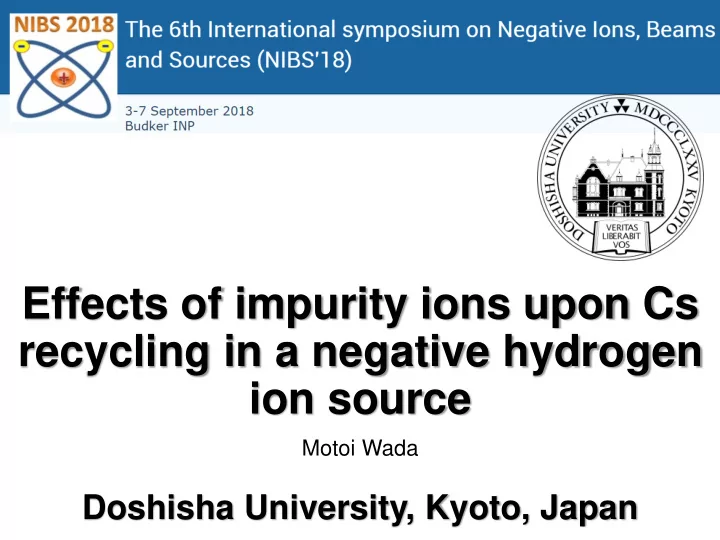

Effects of impurity ions upon Cs recycling in a negative hydrogen ion source Motoi Wada Doshisha University, Kyoto, Japan
Extraction region of a H - source • Surface collision B • Reflection • Desorption H 0 H - • Implantation H - H + • Plasma-wall energy H - exchange • Thermalization H 0 • Collisions H + H - H + • Adsorption • Electron injection H 0 H - • Sheath formation H + • Magnetic field H 0 H + • Potential profile
Impurities in a H - source • Surface collision B • Sputtering PG • Desorption of Cs X 0 H - • Implantation H - X + • Plasma-wall energy X - exchange Cs • Thermalization H 0 • Collisions with H - H + • Adsorption H - H + • Electron H 0 injection H - H + • Sheath formation H 0 • Magnetic field H + • Potential profile
Source of impurities B.X. Han, R.F. Welton, S.N. Murray Jr., T.R. Pennisi, M. Santana, and M.P. Stockli, "OPTICAL EMISSION SPECTROSCOPY STUDIES OF THE SPALLATION NEUTRON SOURCE (SNS) H - ION SOURCE", Proceedings of IPAC2012, TUPPD048, New Orleans, Louisiana, USA (2012).
Two configurations
Ionization cascades e - H + H + H - H + H + Cs Fe, Ni, Cr
Treatment of the adsorbed layer • Both adsorption and retention form interlayers. • ACAT configures nucleus location by layers. • Empty site/vacancy are generated by random number. Cs H Mo R 0 = N -1/3 [cm] N : Number density of target atoms [#/cm 3 ]
72% Fe, 10% Ni, 16% Cr and 2% Mo 316 S.S. Fe, Cr, Ni, Mo Cs Surface binding energy 4.1 eV for Cr 4.28 eV for Fe 4.44 eV for Ni.
Cs removal Fe + Cs H/D Mo
Small difference
Motivation A. Krylov, D. Boilson, U. Fantz, R.S. Hemsworth,O. Provitina, S. Pontremoli and B. Zaniol, "Caesium and tungsten behaviour in the filamented arc driven Kamaboko-III negative ion source", Nucl. Fusion 46, S324(2006).
Cu found in the source
Back streaming ion foot print: NIFS source K. Ikeda, M. Kisaki, H. Nakano, K. Nagaoka, M. Osakabe, S. Kamio, K. Tsumori, S. Geng, Y. Takeiri, AIP Conference Proceedings 1869, 050004 (2017).
Mo/Ni coatings to reduce sputtering yields
Observation of higher Cs consumption rate
Mass effect is serious! Cs H/D Mo • ACAT (Atomic Collision in Amorphous Target) computed collision cascades for both the both back end-plate and the PG. • Deuterium atoms occupying the layer in between Cs and Mo (bulk PG) enhances collision cascade in the subsurface layer. • The collision cascade in the subsurface layer enlarges Cs sputtering yields; more Cs is lost in deuterium discharge.
Complicated process 100 kV p Cs D - D - D + Cu Cs D, Cs D - D + D - D + Cs D - D - Cs Cu V b V ext V acc
Lower threshold/larger yields Cs H/D Mo
Faster removal Cs H/D Mo
Cs H/D Mo
Cu + Cs H Mo
Cs H M o
Source of Cs? Cs H Mo
Cs self-sputtering effect Cs H Mo
W Coatings on source components Cs H W
Effectiveness of W coating
Fuzzy diverter surface Kenta Doi et al., presented at 13 th ISFNT, Kyoto, September, 2017.
Dusts and deposits on the wall
Summary • Austenitic stainless steel preferentially emits Cr under a bombardment of energetic protons. • Impurity ions released from stainless-steel wall can remove Cs with 10 eV incident energy. Any potential difference between the plasma electrode and the plasma potential above 10 V can cause sputtering. • Magnitude of back-streaming positive ion current should be properly evaluated to estimate the effect upon impurity emission. • Copper exhibits high sputtering yields against protons and deuterons above 100 eV incident energy. Coating the Faraday shield surface with Mo will reduce impurity emission. • Coating the Faraday shield with W may reduce the impurity emission even smaller.
Recommend
More recommend